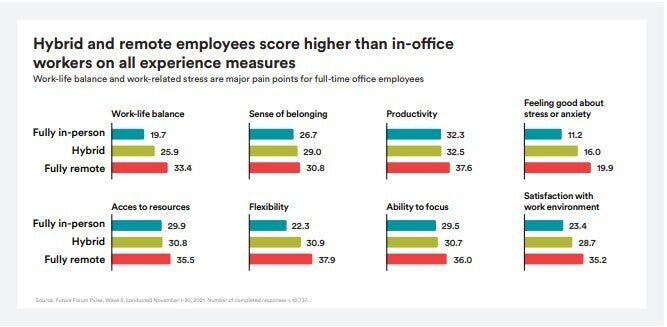































People of color, women, and working mothers are opting for flexible work arrangements at higher rates than their white, male peers, according to a recent Future Forum survey focused on knowledge workers.
In the US, white knowledge workers are spending the most time in the office by a significant margin - as much as 17% more time, according to the Future Forum, a consortium launched by Slack in 2020. The desire for flexibility is particularly strong among people who have historically been underrepresented in knowledge work, the survey found.
Knowledge workers are professionals who have an expertise in their field and "think" for a living; they work in a variety of jobs and fields, including software developers, medical research scientists, engineers, financial analysts, construction managers, and teachers.
"Executives are now acknowledging that there has been a shift in the past two years, and they don't know how to create equity in this new normal," Ella Washington, an organizational psychologist and professor at Georgetown University's McDonough School of Business, said in a statement. "This is an opportunity for organizations to reevaluate, refresh, or maybe even start over with some of their management processes, from performance evaluation to diversity and inclusion."
 Future Forum Pulse (January 25, 2022)
Future Forum Pulse (January 25, 2022) Future Forum describes its mission as addressing flexible, inclusive, and connected workforce issues. The forum conducts research and holds events for corporate executives to help them create people-centered and digital-first workplaces.
The latest Future Forum Pulse surveyed 10,737 knowledge workers in the US, Australia, France, Germany, Japan and the UK between Nov. 1 and Jan. 30. The survey was administered by a third-party vendor and did not target Slack employees or customers.
Among its findings:
The Future Forum survey lines up with other research. Gartner, for example, found that women and people of color are less likely to return to the office post-pandemic for a variety of reasons, including caretaker responsibilities, worries about safety, and feelings of inclusion.
 Future Forum Pulse (January 25, 2022)
Future Forum Pulse (January 25, 2022) In addition, 73% of women who were fully on-site before the pandemic, but have been remote since, agree their expectations for working flexibly have increased. And, 51% said they feel safer since switching to remote work.
The biggest concern among workers as companies juggle back-to-the-office plans, hybrid options, and remote work is the rise of "proximity bias" - inequities between co-located and remote employees. With underrepresented groups spending less time in the office, access to professional opportunities could suffer - from face time with the boss to promotions and career mobility.
"Sadly, early indicators suggest these barriers will be worsened in the hybrid world," Emily Strother, a senior principal in the Gartner's HR practice, said. "With underrepresented employees being more likely to choose remote over in-office work, their visibility to senior leaders suffers. And managers' perceptions that on-site workers are more productive suggests that underrepresented talent working remotely will be more vulnerable to biased performance reviews."
Women are also concerned. In a hybrid work model - where they are more likely than men to take advantage of remote work - they could suffer from "leadership proximity bias," according to Strother. In fact, 59% of women knowledge workers think in-office employees will be seen as higher performers, and 78% think in-office workers are more likely to be promoted, according to Gartner.
Executives are taking note, with 41% now citing inequities between on-site and at-home workers as their top priority when it comes to flexible work - up 8% from the previous quarter, according to Future Forum's survey.
Educating business leaders is the key to dealing with those kinds of issues, according to Strother. Leading organizations, she said, are tackling proximity bias in a variety of ways, including:
Managers are the key touchpoint for employees in a hybrid world and serve as stewards of communication, especially when juggling work arrangements, according to Strother. "To help mitigate bias in a hybrid world, organizations must educate leaders about the places in their talent lifecycle most at-risk for exclusion," she said. "For instance, onboarding is particularly difficult in a hybrid world. By engaging all employees equally, organizations can ensure the process is fair."
Workplaces that are considered "fair" by employees also benefit from higher employee performance, according to Gartner.
A Gartner 2021 ReimagineHR Employee Survey of 3,500 employees conducted in 3Q21 found that employees who work in a high fairness environment perform at a level 26% higher than those who don't - and are 27% less likely to quit.
"In today's increasingly competitive job market, fairness and equity are table stakes for attracting and retaining talent," Strother said.
 Tags quentes :
Indústria de Tecnologia
Competências em TI
Diversidade e Inclusão
Tags quentes :
Indústria de Tecnologia
Competências em TI
Diversidade e Inclusão